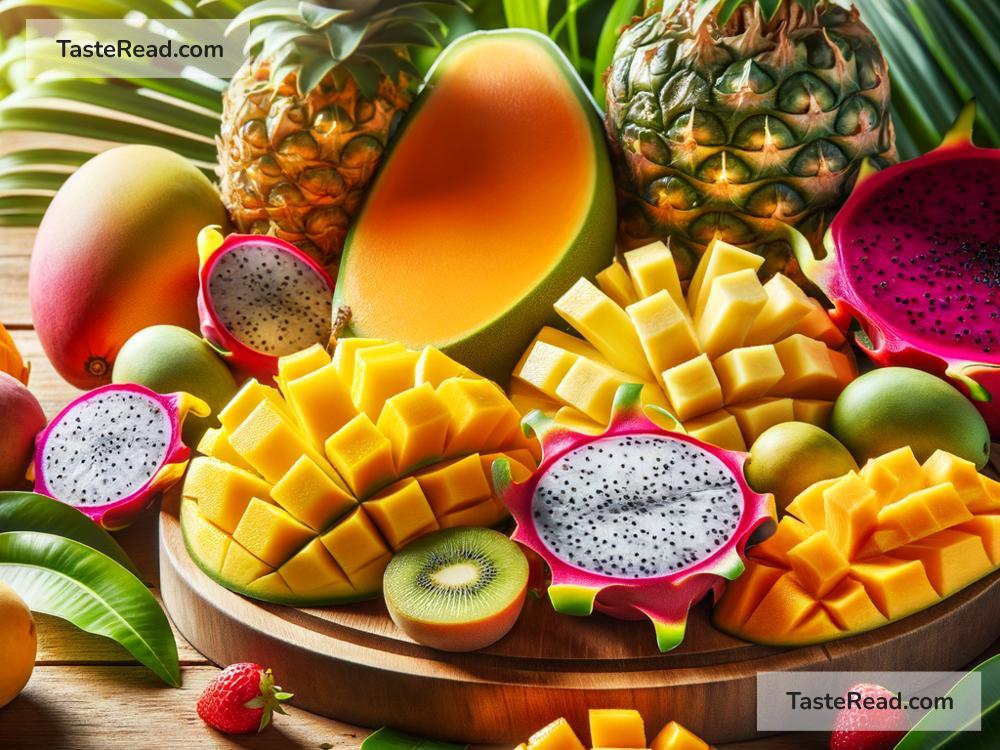The Science Behind the Sweetness of Tropical Fruits
Have you ever bitten into a juicy mango or a ripe pineapple and wondered why tropical fruits taste so sweet and delicious? Tropical fruits like bananas, papayas, and guavas are popular because of their vibrant flavors, delightful textures, and natural sweetness. But what makes tropical fruits taste so sweet? Let’s dive into the science behind their flavorful magic.
What Makes Tropical Fruits Sweet?
The sweetness of tropical fruits comes from natural sugars like glucose, fructose, and sucrose. These sugars are carbohydrates that not only give fruits their sweet taste but also serve as an energy source for plants and animals alike.
Imagine a plant as a mini factory that produces food. Through photosynthesis, plants use sunlight, water, and carbon dioxide to create sugar. This sugar is stored in the fruit, which serves as the plant’s effort to attract animals. Animals eat the fruit and spread the plant’s seeds, allowing it to grow in new places. Sweetness isn’t just tasty — it’s part of the fruit’s survival strategy!
Why Are Tropical Fruits Sweeter Than Many Other Fruits?
Tropical fruits often grow in warm, sunny environments close to the equator, where there’s plenty of sunlight all year round. Sunlight plays a huge role in driving photosynthesis, the process that creates sugar.
Because tropical plants get so much sunlight, they can produce more sugar than fruits found in colder regions. This is why tropical fruits like mangos, lychees, and jackfruits taste sweeter than many temperate fruits, such as apples or pears.
The high sugar content in tropical fruits is also influenced by their ripening process. Tropical fruits ripen more quickly due to warm temperatures. As a fruit ripens, enzymes in the fruit break down starch into sugars. These sugars give the fruit its sweet flavor. The longer the fruit ripens, the sweeter and softer it becomes.
Types of Sugar Found in Tropical Fruits
Tropical fruits contain three main types of sugars:
- Glucose: This is the simplest sugar and the fastest to be absorbed by the body. It provides quick energy and is found in most fruits, including bananas, mangos, and pineapples.
- Fructose: Known as “fruit sugar,” fructose is responsible for the lush sweetness in tropical fruits. Fruits like dragon fruit often have higher fructose content, which makes them taste extra sweet.
- Sucrose: Often called table sugar, sucrose is a combination of glucose and fructose. It’s commonly found in tropical fruits, giving them a balanced sweetness. For example, guavas and papayas have a healthy mix of sucrose.
How Do Scientists Measure Sweetness in Fruits?
Scientists use a tool called a refractometer to measure the sweetness in fruits. This gadget measures the sugar content, which is expressed in units called “Brix.” The higher the Brix number, the sweeter the fruit.
For example, mangos often have a Brix level of about 13–18, which makes them one of the sweeter tropical fruits. Meanwhile, fruits like pineapples can range from 12–17 Brix, depending on their ripeness. Some of the sweetest fruits can even have Brix levels above 20!
The Role of Acids in Balancing Sweetness
Here’s something interesting: tropical fruits aren’t just sweet because of sugar. They also contain natural acids, such as citric acid and malic acid, which help balance their flavor.
For instance, think of a ripe pineapple. While it’s definitely sweet, it also has hints of tartness. That tangy flavor comes from citric acid, which creates a refreshing taste that keeps the sweetness from overwhelming.
The balance between sugar and acid is crucial. Fruits like mangos and passion fruits are loved because they strike the perfect harmony, offering a mix of sweet and tangy flavors. This balance is what makes tropical fruits so addictive!
Why Do Tropical Fruits Smell and Taste So Unique?
Sweetness is only part of what makes tropical fruits special. Their aroma and flavor also come from natural compounds called “volatile molecules.”
These molecules evaporate easily, sending fruity aromas into the air. For instance, a ripe banana gets its distinct smell from a compound called isoamyl acetate. Similarly, a mango’s tropical scent comes from unique compounds like terpenes.
Tropical fruits have a wide variety of these fragrant molecules, making each fruit stand out. Scientists believe the sunny conditions in the tropics give these fruits more time to develop their rich aromas.
How Can You Enjoy Tropical Fruits at Their Sweetest?
If you want to enjoy tropical fruits at their peak sweetness, timing is key. Eating fruits that are fully ripe ensures the sugars have developed and the acids are balanced.
To check if a mango is ripe, look for soft spots and bright yellow-orange skin. For pineapples, smell the base of the fruit — a sweet aroma indicates it’s ready to eat. Bananas taste best when they have brown spots on the peel, signaling perfect sweetness.
Conclusion
The sweetness of tropical fruits is a marvel of science and nature. Sunlight, ripening enzymes, sugar types, and the balance of acids all work together to create flavors we love. Tropical fruits remind us of the rich biodiversity found near the equator and offer us a sweet taste of sunshine, warmth, and tropical beauty.
So, the next time you enjoy a papaya or sip a fruit smoothie, think about the science behind the sweetness — it’s more than just delicious, it’s a fascinating glimpse into nature’s wonders!


